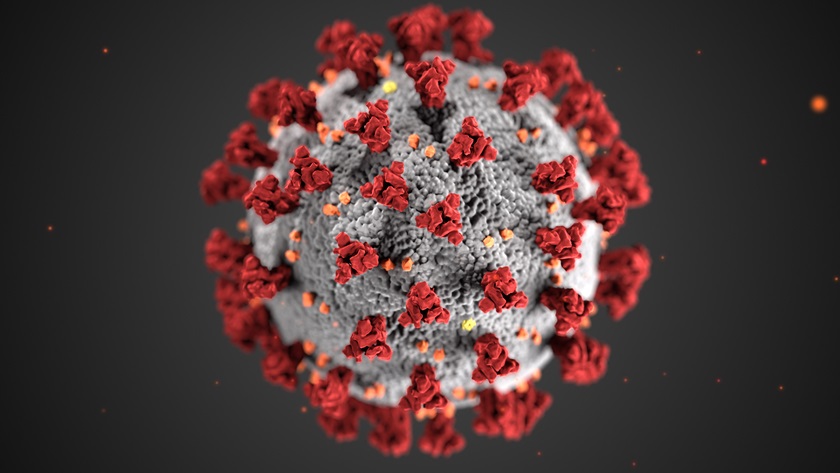
3,900 vaccine doses expected Monday

Graphic courtesy of CDC
This illustration from the Centers for Disease Control and Prevention (CDC), reveals ultrastructural morphology exhibited by coronaviruses. A novel coronavirus, named Severe Acute Respiratory Syndrome coronavirus 2 (SARS-CoV-2), was identified as the cause of an outbreak of respiratory illness first detected in Wuhan, China, in 2019. The illness caused by this virus has been named coronavirus disease 2019 (COVID-19).
WINDOW ROCK
The Navajo Nation will be receiving 3,900 Pfizer COVID-19 vaccines on Monday and 7,800 Moderna vaccines seven days after, according to Navajo Area Indian Health Service.
Loretta Christensen, chief medical officer of Navajo Area IHS, said these vaccines will be sent to Gallup Indian Medical Center on Monday, and the following day Northern Navajo Medical Center and Chinle Health Center will be receiving the much-anticipated vaccine. These facilities have the ultra-cold freezers needed to store the vaccine safely.
“We are placing it strategically in those freezers so we can take that vaccine to other health centers and hospitals,” explained Christensen. “The distribution team will go to these large sites and we will take the amount of vaccine that is assigned to all the other facilities and will directly drive it to their facilities. They have all told us they are ready to receive it and place it in proper storage.”
Both COVID-19 vaccines, Pfizer and Moderna, will require two separate doses to be administered at two different times. On Thursday, the U.S. Food and Drug Administration’s advisory committee recommended the authorization of the Pfizer-BioNTech vaccine for COVID-19, which would allow for the distribution of the vaccine based on the Centers for Disease Control’s phased distribution plan. Final FDA approval is pending, but is expected to happen this weekend.
Health professionals warned of a post-Thanksgiving surge in COVID-19 cases, and on Thursday the Navajo Nation experienced another high number of COVID-19 positive cases with a reported 347 new cases and 699 deaths. Reports indicate that 10,256 individuals have recovered from COVID-19, and 178,801 COVID-19 tests have been administered. The total number of positive COVID-19 cases is now 18,943, which means roughly 11 percent of Navajos living on the reservation have tested positive at
some point.
As of Dec. 8, over 43,000 people have volunteered for the Pfizer vaccine trials worldwide, including members of the Navajo Nation and the White Mountain Apache Tribe. Moderna is also seeking approval from the FDA for its COVID-19 vaccine, which has also shown 94.5-percent effectiveness. There is a distribution plan for the reservation.
“In accordance with the CDC recommendations, the first doses of the vaccine will be given to health care workers and those living in long-term assisted living facilities, on a voluntary basis,” stated President Jonathan Nez, who spoke with Pfizer’s CEO on Wednesday about the vaccine. “This will be a challenging process, but our health care experts are doing the very best they can while they also continue to work around the clock to fight for all of us on the frontlines.”
As a public service, the Navajo Times is making all coverage of the coronavirus pandemic fully available on its website. Please support the Times by subscribing.
How to protect yourself and others.
Why masks work. Which masks are best.
Resources for coronavirus assistance
There will be three phases of vaccination, starting with the “early or limited dose phase.” This phase is where not a huge amount of vaccine is available but there is enough to cover the first priority.
The first priority (1A) is: health care workers; EMS staff; traditional practioners; all staff and patients in long-term nursing facilities. The next group, 1B, will include essential workers who provide food, supplies, transportation or utilities to the Navajo people. The third group, 1C, is all high-risk patients and adults over 65.
“The next phase there will be a lot more vaccines available,” said Christensen. “We anticipate this in early 2021. We have great confidence on the vaccine that is coming out. Getting the vaccine is voluntary … but it’s important to vaccinate as many people that we can, while we practice safe measures we shared with you: watch your distance, wash your hands, and wear your masks.”
Laura Hammitt, director of infectious disease programs at the John Hopkins Center for American Indian Health, said 163 Navajo and 58 White Mountain Apache tribal members volunteered for the Pfizer vaccine trial and overall there were 463 Native American participants.
“The main results were released last month and published today,” said Hammitt, who said she would not hesitate to take this vaccination and will encourage her family to take it as well. “After two doses, the vaccine was found to be 95 percent effective at preventing COVID-19. This is really remarkable.”
Worldwide there were 170 cases of COVID-19 illness among the study participants, and 162 occurred in people who did not get the vaccine. Only eight occurred in people who received two doses of the
vaccine.
Side effects for the most part were mild, including pain where the shot was given, tiredness, headaches and muscle aches. These side effects went away after a couple of days, said Hammitt. She
compared the side effects to those of the SHINGRIX shingles vaccine.
“We did see in the clinical trial that older adults were less likely to have side effects,” said Hammitt. “About one in six people, who were 55 or younger developed a fever … 55 and older one in 10 developed a fever.”








 Highway 264,
Highway 264, I-40, WB @ Winslow
I-40, WB @ Winslow